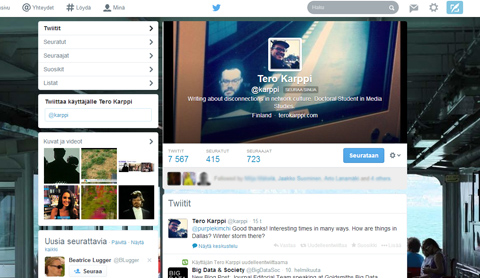Researcher in Social Media: Where to Be Active and What to Share?
Researchers who are active in social media should present themselves as individuals and show their human characteristics. Sharing only research results is not interesting, says Tero Karppi who researches Facebook.

“The thought of branding in social media is in a way distasteful” says social media researcher Tero Karppi when I ask him about researchers’ self-branding in social media.
In March, Karppi will defend his doctoral dissertation on Facebook and its users’ engagement. As a researcher, he is active on Twitter as well. Why this kind of an attitude towards researchers’ self-branding?
–Branding in social media represents the thought that researchers are a product which is built on images and not on the substance of their know-how. A researcher who actively brands him or herself in different social media is not necessarily far away from a catchphrase slinging sketch show character, argues Karppi.
According to Karppi, researchers can achieve a great deal in social media, but self-branding is not the right approach. In social media, expertise and humanity should meet in the right proportion. At their best, researchers genuinely take part in conversations, comment and respond to others, also to complete strangers. Few people are eager to follow deliberate self-branding. A researcher, who shares only his or her own articles on Twitter once a month, will lose the followers interest very quickly.
–Research groups can of course share only factual content, but researchers as individuals with their human characteristics are much more interesting to follow.
Finding New Ideas for Research from Social Media
An active presence in social media has become an important way for many researchers to stay in contact with colleagues and participate in discussions in their own field of study. In addition, one can find new research ideas or subjects in social media. Karppi adds that it also possible to get visibility for your own research through social media.
–The university’s so-called third task, social influence and communality, is often forgotten. Even socially significant research can just gather dust somewhere if no one is aware of it. Social media is not a fast track to happiness but it can be used to introduce new research to the international research community and to the wider audience as well.
Visibility in social media is an important way to network. According to Karppi, Twitter is a great medium for this. Even though the tweets are short, you can share links to interesting articles and discussions with them.
–In Twitter, anyone can follow anyone. Twitter is not based on existing connections or relationships and that is why you can easily network in Twitter. For example, in conferences, Twitter acquaintances band together and the conversations that started online continue face to face.
“Research Is Not Always Dead Serious”
Humour has been one of the eternal questions of the short history of social media. In one brief inappropriate tweet, you can get yourself fired. On the other hand, Arman Alizad and Tuomas Enbuske, who are in the leading edge of the Finnish Twitter users, have ridden a wave of popularity by using racy humour in their tweets.
How should those who present themselves as researchers in social media react to using humour?
–Research is not always dead serious. Researchers are usually dragged in front of media to represent stiff expert positions where they cannot use humour. This illusion of the gloominess of research can be taken down by presenting yourself well in social media.
According to Karppi, the credibility of a researcher hardly rides on using humour. Of course, using inconsiderate humour in social media can have severe consequences, but this is also true in the world outside the Internet.
Nevertheless, humour is only one possible stylistic device in social media. If it does not feel natural, you should avoid trying to banter about cats or making poor jokes. However, researchers shouldn’t just hide behind the research result in their own comfortable field of research but also write something about themselves or about a researcher’s daily routine.
–Researchers in social media do not only share research results but also let off some steam about the research process and about the difficulties of writing or applying for grants. Those who are battling against bureaucracy can easily find peer support, says Karppi.
Where to Be Seen, What to Be Aware of?
The field of research has a great effect on which social medium the researcher might want to be seen in. In any case, each researcher should at least consider updating their CV online.
–For example, one possibility is the Academia.edu web pages, where you can also upload research articles. It’s a kind of a new form of a CV. Of course you should consider copyright when posting articles on Academia.edu as well: who owns the published article, the researcher or the publisher?
Karppi advises to carefully consider the situations where the employer’s or funder’s point of view could conflict with your own. For this reason, many researchers from American or British universities typically add a note to their social media profiles where they highlight that the opinions are their own and do not represent those of their employer.
–At the University of Kansas, a professor of journalism was suspended after he criticised NRA on Twitter. Nowadays, it is surely quite healthy to treat these things with a pinch of paranoia, says Karppi.
MA Tero Karppi (@karppi) is a researcher in the Department of Media Studies at the University of Turku. In March , he is defending his dissertation on user engagement and Facebook.
Hannu Aaltonen
Translation: Mari Ratia